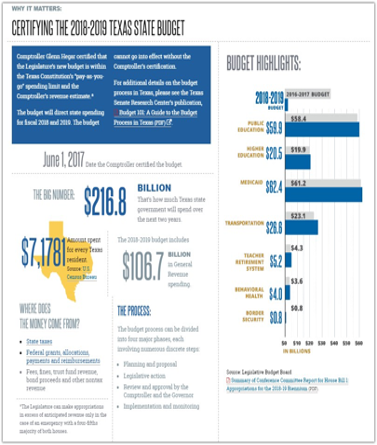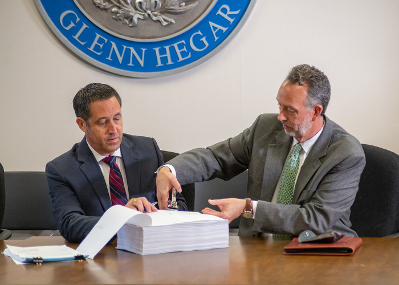Texas State Budgeting
Overview
Texas State Budgeting
Learning Objective
By the end of this section, you will be able to:
- Outline the procedure for a state budget to be developed and approved
The Budgetary Process
The Texas Constitution has long required state government to operate on a two- year budget cycle. This has the advantage of forcing lawmakers and agencies to think ahead in a way that states with annual budgets do not.
Responsibility for preparing an initial draft of the budget is shared by the governor, through the Governor's Office of Budget, Planning, and Policy (GOBPP) and the legislature through the Legislative Budget Board (LBB). The LBB appoints a budget director, who brings together budgeting requests from various state agencies and prepares appropriations bills for them.
Although it does not need to be said, preparing and implementing a state budget is extremely complex.
The Texas state budgetary process involves two stages.
In the first stage, the LBB develops a draft budget based on detailed legislative appropriations requests (LAR) from each state agency. The draft budget follows a series of steps. The strategic plans created by each agency provides the basis for LBB funding recommendations for each agency.
The LARs from each state agency are sent to LBB, the Comptroller's office, and several other state agencies by the end of summer or early fall. The LBB and the GOBPP then hold hearings with each agency regarding the content of their LAR. While the draft budgets are being prepared, the comptroller's office prepares the Biennial Revenue Estimate (BRE), a detailed forecast of the revenue that the state is expected to take in over the next biennium, with a defined ceiling on what the legislature can spend.
The second stage of the budgetary process involves the legislative process. By the seventh day of each regular legislative session, appropriations bills are submitted by the LBB to the Texas House Committee on Appropriations and the Senate Finance Committee, who hold hearings on the bill and make changes to it reflecting the BRE's limits and their funding priorities. When the committees complete their final versions of the bill, they send them to the full House and Senate for approval.
Differences between the two versions of the bill are then reconciled in a conference committee, which is composed of representatives from the Senate and House.

At the conclusion of a state legislative session, the Constitution provides that the state’s budget cannot take effect until “certified” by the Comptroller – his or her official ruling that the state should have enough money to pay for everything in the general appropriations bill.

An additional twist in the process involves the Texas governor’s power of line-item veto.
Texas governors have been largely removed from the state’s budget-writing process. While governors still transmit a set of usually-vague “budget priorities” to the legislature at the beginning of each session, the actual draft budget is prepared by the Legislative Budget Board (LBB).
At the end of the budget process, however, Texas governors have a power U.S. presidents can only dream about. The governor is empowered under the state constitution to review an appropriations bill and to veto individual spending items without vetoing the entire bill. Most Texas governors have used this power sparingly. Governor Greg Abbott signed the 2020-2021 appropriations bill without a single line-item veto after having vetoed $120 million in spending from the previous session’s budget.
References and Further Reading
The Texas Budget Process: A Primer. Certifying the 2018-2019 Texas State Budget [Infographic].
Focus on State Finance: Writing the State Budget. House Resource Organization (PDF) February 2019. No. 86-1.
Senate Research Center. Budget 101: A Guide to the Budget Process in Texas. January 2019.
Texas governor signs $217 billion budget, vetoes $120 million. Texas Tribune. Edgar Walters.
Licensing and Attribution
CC LICENSED CONTENT, ORIGINAL
Texas State Budgeting. Authored by: Andrew Teas. License: CC BY: Attribution